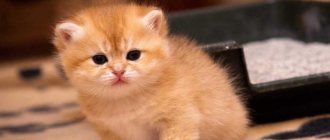Often doubts creep into the minds of cat breeders that cannot find a rational explanation: why cats are afraid of water. Are they really afraid of her? After all, when a cat reacts to splashes, its pupils do not dilate, it does not try to attack or hide in a corner - it simply closes its eyes and tries to run away.
If you try to wash your pet in the shower or pour water on it, the reaction of fear is obvious:
- the pupils will dilate;
- the pulse will increase;
- attempts are made to escape into a dark corner.
Why cats don't like to swim
Zoologists don't know exactly why cats don't like water. There are two theories to explain this behavior.
- The first has to do with origin. The ancestors of modern domestic cats come from African deserts, where there is simply no time to get used to a humid environment: it is not there all year round, and during the rainy season, a rapid stream flows in place of the usual hunting trails. This version is supported by the habits of other savannah cats - lions. They prefer to take water exclusively internally, regardless of the heat.
- The second version is hunting. It's all because of wet fur. Thermoregulation and fur structure of cats is different from that of dogs. If a cat gets wet, the skin temperature rises sharply and the fur begins to smell. For a predator hunting from an ambush, this is akin to disaster.
In the case of dousing, the suddenness of the situation adds to the unpleasant sensations. When a pet is washed, the wet fur is accompanied by a feeling of intense cold (have you noticed how a washed cat trembles?), the sharp noise of a gurgling stream in the bathroom, the smell of pet shampoo and a feeling of fixation. The pet is extremely uncomfortable.
Instinctively, he regards such a situation as danger. It comes as no surprise that cats are afraid of water. More precisely, they do not like to swim and get wet in it.
Water is stress
The cat begins to experience stress even before the bathing begins - when it is brought into the bathroom. The animal, with its excellent olfactory abilities, detects the smell of shampoo, with which it has had unpleasant sensations since the last bath; the murmur of water also does not cause delight in the cat - it understands what is about to happen to it and is frightened.
Owners are not very good at holding their pets under running water for the time necessary for a quality wash - some cats start hysterical even before the bath begins, others hold out for 2-5 minutes, and only a few patiently wait for the end of the unpleasant procedure.
The cat begins to feel stressed even before the bath begins.
But this does not mean that the most seasoned of animals are calm about bathing and water in general. Monitor the condition of your pet during washing: if he is pinched, his heart is pounding, calm the cat down, distract him with his favorite toy or favorite treat, so that the animal develops pleasant associations associated with bathing: after plunging into the water, something will definitely happen something interesting (game), or something tasty (meat).
Can cats swim?
Almost all animals can swim, cats are no exception. Primates (including humans) are poor at overcoming water obstacles from birth. Giraffes are probably not the best swimmers, but no practical experiments have been carried out with giraffes and a swimming pool.
Knowing how to swim and loving it are two different things. Most cats do not need to be bathed and can handle their hygiene on their own. Moisture dries out the delicate skin of most furry pets.
The exception is Sphynx and other hairless cats. There are two options:
- gently and carefully accustom to water from childhood;
- do without washing, wiping their skin with a soft, damp towel.
By the way, if you have to wash your cat (if the animal is very dirty and the dirt cannot be licked off or there is too much dirt), you need to use a special shampoo for animals.
It is theoretically possible to accustom a cat to bathing, but it is worth remembering that these wayward animals will not do what they do not want. A cat may happily play with a drinking fountain or a stream from a faucet, and may even try to catch live fish while they are swimming in a basin (or in an aquarium), but will not be at all happy with washing.
However, there are animals that can take a bath with their owner. This mostly depends on the personality of the individual cat, but there are breeds that are prone to bathing. By the way, if you decide to teach your cat to swim, remember: he may like to drink from the toilet.
Why don't cats drink enough?
An interesting fact is that a cat’s body has a very small need for water. These animals are able to replenish its supply simply by eating well. It is worth noting that we are talking about cats receiving a balanced diet, and not those who are fed dry food. Therefore, experienced owners do not worry if they notice that their pet is not drinking water.
Another reason why a cat does not drink water is the ability of its body to reduce water loss due to the concentration of urine. Scientists explain this by the origin of the current species from African wild cats, which were forced to live in the arid territory of North Africa.
Owners should remember that cats often need access to water at night and, naturally, on hot, dry days.
It is worth noting that cats love to drink water at night. Therefore, all owners need to make sure that their pet always has access to a bowl of water at any time of the day.
Cat breeds that love water
As you know, rules have exceptions. There are breeds that have the opposite tendency and love water treatments.
Turkish van
Representatives of this breed approach swimming as an art: they are not afraid of water and love to swim. These cats, which have been fishing in Lake Van since ancient times, can dive. They have no undercoat, so water treatments cause them much less discomfort than most breeds.
Turkish Angora
If not a fan of swimming, she definitely likes to play with water. Kittens that are taught to swim by their mother are almost guaranteed to swim. However, such animals are rare.
Maine Coon
Many coons prefer to drink not from a bowl, but to dip their paw into the bowl and then lick it. They spray more than they drink, but it's even more fun. Maine Coons have a special relationship with their bowl. Often before drinking, they dig for a long time near it, turn it over and spread the water throughout the house. Therefore, choose massive and deep drinking containers. Please note that individuals of this breed do not like to take long showers.
Bengal
Like previous individuals, they love to suck their paws. These are unusual cats with interesting qualities:
- are not afraid of water;
- are friends with dogs;
- easily accustomed to a harness;
- love walks;
- They steal no worse than forty.
Abyssinian
Although the Abyssinian does not have an undercoat, its representatives do not like to swim. However, almost everyone is a fan of flowing water. They also love basins or containers with something interesting - or dirty.
American Bobtails
The vast majority classifies this breed of pet as one that loves water, but most American cats are not afraid of it. In addition, they are attracted to the fact that they can play with the liquid.
Kurilian Bobtails
Like Turkish Vans, Kurbobs are devoid of undercoat, and they love water. How else to survive in the Kuril Islands? True, most representatives of the third or fourth generation of the breed, living far from the Kuril Islands, treat water like any ordinary cat - with disgust and distrust. In a city apartment, a mother is unlikely to be able to teach kittens to love fishing.
Manx
A native island breed from the Isle of Man that loves water. They can play with the streams and even climb under them, but owners should not relax when they decide to wash the cat: it’s one thing when you get into the water yourself, and another thing when they forcefully water and soap it.
The habit of Manx cats to have fun with liquid substances is often attributed to Maine Coons, confusing the breeds due to the consonance of the names. These are different animals with different habits: Manx prefer to show in water, Maine Coons prefer to show in it.
Sphinx
These cats are rarely mentioned among those who do not like water. Hairless cats prefer a warm bath, at a temperature slightly higher than their body - 38.5 degrees. They are one of the few cats quite capable of deciding to take their first bath in adulthood on their own, imitating the owner lying in the bathtub. The liquid does not cause them significant discomfort, since there is nothing special to get wet or dry.
Even those breeds of cats that are supposed to love water are not obliged to entertain their owners by frolicking in the bathtub. Moreover, they may sincerely despise water, like most of their fellows. Therefore, if you want your pet to easily allow himself to be bathed, introduce him to the bath gradually.
Use it when the animal begins to have a good and positive attitude towards water. It is better to lay a towel at the bottom of the cat’s bathing container so that the cat’s paws do not slide on wet enamel or plastic, eliminating the fear of slipping. And most importantly: even a cat who is ready to allow himself to be washed can be irritated with water by pressing too hard or abruptly and unexpectedly dropping him into the container.
Turkish van
Legend has it that Van jumped off Noah's Ark to cross the ocean to Turkey. However, he discovered that it was too hot in Turkey, so to cool himself down, he chose an original way - to swim in the cool Lake Van.
The Turkish Van is a breed that really loves to swim, so don't be surprised when he happily takes a dip in your bathtub or toilet.
Possible hypothermia and fear of being overheated
Cat fur has a specific structure. The fur provides her with impeccable protection. A pet's fur coat plays the role of thermal insulation, due to the fact that air is retained with the help of fur hairs and a protective layer is formed.
Water that gets on a cat's fur displaces the air membrane, and the fur loses its ability to insulate heat. A wet cat quickly freezes and cannot warm itself until it dries. A cat that gets into water can get sick.
That is, the cat is not afraid of water, it avoids the possible negative consequences that await it as a result of getting wet. They cannot shake water off their fur and it is very unpleasant for them to get wet.
In hot weather, cats also do not want to bathe, and the reason again has to do with insulation. Losing this ability, wool cannot protect the animal from heat and sunlight.
Main reasons for fear
The fear of water has been instinctively ingrained in cats since ancient times.
Even the ancestors of representatives of the cat family had no need to contact the aquatic environment to obtain food, hunt mice and rodents, and getting wet caused only one problem: Impaired heat exchange. When a cat's fur gets wet, it loses its insulating function, causing the animal to become very cold.
Infections. Dirt actively adheres to wet fur, which leads to the accumulation of bacteria and other pathogens, and this is extremely dangerous for the cat’s health.
Smell. The wet fur begins to smell quite strongly. This specific aroma interferes with hunting, scaring away potential prey, and also attracts dangerous predators.
Overheat. During the hot season, the wool layer performs a protective function, protecting the cat’s delicate skin from exposure to aggressive ultraviolet rays. When the coat gets wet, the protective function is lost, and the animal can suffer seriously from overheating.
Wash off protective lubricant. Cat fur is coated with a special protective lubricant, invisible to the naked eye, which gives it shine and luster and protects it from breakage and loss. Frequent contact with water leads to degreasing of the animal's fur and skin and worsens its condition.
Drying time. After bathing, as the results of numerous studies and experiments have shown, a cat needs at least several hours to get its fur in order.
Chlorinated water. Animals have an extremely negative attitude towards the smell of chlorine, which is characteristic of tap water. This problem can be solved by using pre-boiled and settled water for bathing.
Misbehavior of the owner. Often, due to the careless actions of the owners during the bathing process, water gets into the pet’s ears, which can lead to serious consequences, including inflammatory processes and deterioration of hearing function.
Therefore, it is necessary to exercise great caution when bathing your pet, and even better, place protective cotton swabs in the ear canals of the purr in advance and avoid getting copious amounts of liquid on the cat’s head.
However, some cats happily splash in the water without experiencing any fear.
How do cats perceive being washed?
Cosmetics, which are often used during the washing process, greatly irritate the charm of your pet. Copious pouring of water is perceived as a blow, and the sensory system reacts accordingly - you need to escape.
- There are more than 40 breeds of the cat family in the world.
- It is generally accepted that the animal was domesticated by the Egyptians. It's a delusion. The first cats were discovered in Cyprus.
- During the Spanish Inquisition, cats were recognized as servants of the devil, and tens of thousands of pets were destroyed by order of the bishop. This led to the rapid reproduction of rats, and as a result, the spread of plague.
Truth or Myth
Of course, this is actually just a legend. In fact, felines are excellent swimmers. This applies to tigers, panthers, pumas and many others. Why should the domestic cat be an exception?
Another question is that the vast majority of cats simply do not like to swim, or rather, to get their skin wet. We'll talk about the reasons for this a little later. All mammals, without exception, can swim. Cruel and rational evolution has long since eliminated all those not endowed with this skill. After all, there are quite a lot of critical situations when cats rush into the water without hesitation :
- The need to escape in a flood.
- Everyday hunting.
- Fleeing from a more dangerous enemy.
This is not a complete list of reasons for cats to plunge into water, including ice water. True, modern pets simply do not find themselves in such situations. They are not threatened by flooding, food is obtained in a bowl, and they usually do not encounter predators that pose a threat.
Many cat owners say that their pets love to swim or at least sit in the water. Despite this, on the Internet you can easily find hundreds of videos with scenes of cats swimming - they quite successfully overcome large water obstacles. Others don’t swim, but they like to sit in warm water, in the bathroom.











